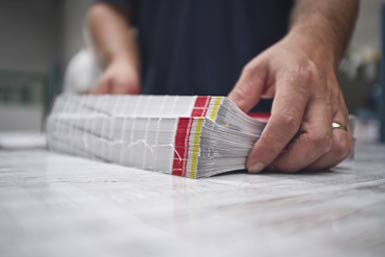The world is firmly planted in the digital age. Everyone is connected to everybody and everything, 24/7. We email, text, post, tweet, snap, and record video constantly. And yet, the future of the printing industry is alive and well. This is because we still have a demand for print.
The Future of The Printing Industry
“Print?!” you say to yourself, “What in the world are we printing in 2015?”
Well, for starters, things like resumes, business cards, contracts, mortgages, license agreements, wedding invitations and diplomas.
“Ok, fine, stuff like that, but the future of the printing industry is still going to die,” you say.
And perhaps you’re right. There are plenty of people who would agree with you. In fact, a lot of people are saying that it will die really soon. But there is an entire section of Amazon devoted to dot matrix printers! (Nothing like 1983 technology starting at $200 in 2015.) And with digital music sales only just beginning to surpass physical album sales, maybe we shouldn’t be so quick to throw away the printer. Maybe the question we should be asking is not when will the printer die, but why does the printer continue to stay alive?
Target Audiences
The future of printing industry is alive and well because of various target audiences. Printing services are in high demand for specific audiences that base their businesses largely off of paper usage.
Newsweek, which died for lack of revenue, was revived as a smaller, more premium, boutique-like publication.
Allrecipes.com also launched a subscription magazine last year, aimed at the people frequenting their cooking site. Why launch a paid model when your customers are already on your website? Because the customers use it. Even newspapers, which have long been decried as a dying business model, have begun printing on a more effective schedule.
Print is Evolving
The future of the printing industry is only becoming more and more relevant. This is because it is evolving to work in conjunction with the digital age. We’re all familiar with the QR code, printed on everything from signs to brochures to company trucks. This is just one example of how we use printed material as a gateway to digital information. Despite the fact that most information is being stored digitally, the user’s experience still begins with hard copy. Xerox has launched an app that allows the secure transmission of documents after scanning them for businesses. Anybody from a college admissions office to a financial firm could use this technology. It would help to improve workflow and cut down on customer response time. At the same time, making it easier to submit information.
Have you heard of an app called “Clickable Paper?” It’s technology that might just replace QR codes. After scanning an image, paper, ad, book, etc., you could shop for the item on Amazon, read reviews of the product on Facebook, and see the latest news about it on Google. Again, the experience begins with the hard copy. The printed material is what connects the user to digital information.
The fact that we continue asking whether the printing industry is dying is a testament to its future. But testament aside, print is still here. And it’s going to be here for a long time. The future of the printing industry will surely not be resulting in less print soon. People are printing now more than ever. They are just using it for different needs.
NuQuo is a niche, independent consulting firm composed of highly experienced insiders from the printing industry. Find out how we can save your business 30%-50% on all your future business equipment, and service agreements by contacting us at
sales@nuquo.com

